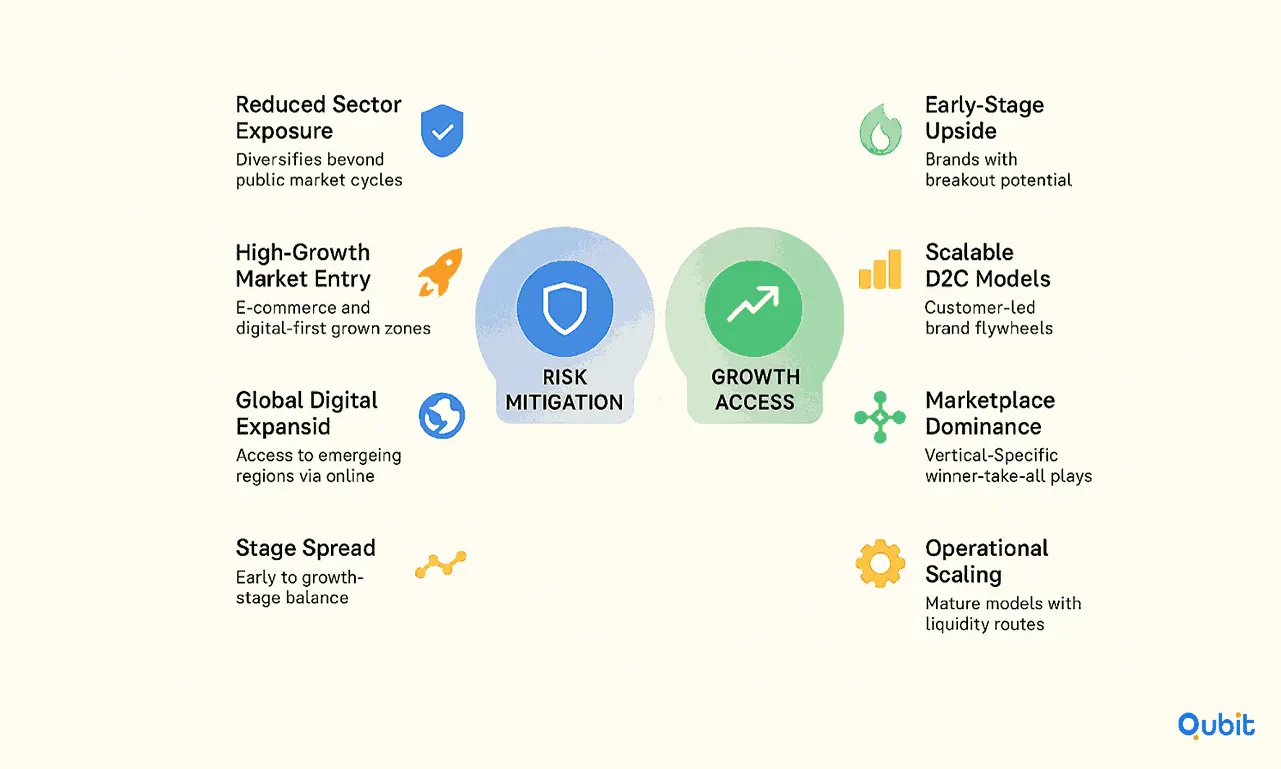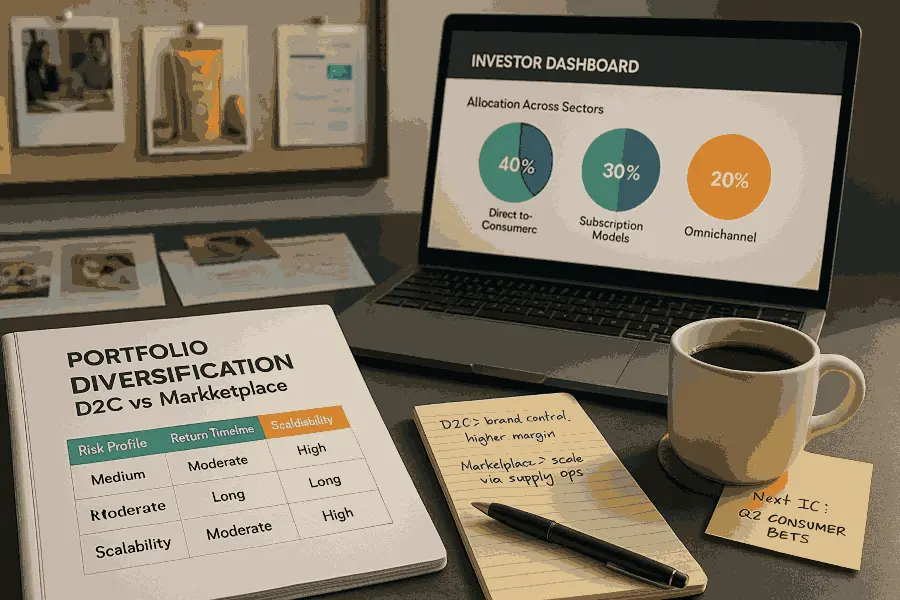India's D2C market alone stands at $12 billion and is expected to grow to $60 billion by FY27 at a compound annual growth rate of nearly 40%. This explosive growth trajectory, combined with the global expansion of marketplace platforms, creates substantial opportunities for investors looking to diversify beyond traditional asset classes while capturing the value of evolving consumer preferences.
For investors, the appeal extends beyond pure financial returns. D2C and marketplace ventures offer exposure to innovative business models, direct customer relationships. This guide provide both portfolio diversification and significant upside potential when properly evaluated and implemented.
Understanding D2C and Marketplace Investment Opportunities
The D2C Revolution: Direct Brand-Consumer Relationships
Direct-to-consumer brands have fundamentally transformed retail by eliminating intermediaries and building direct relationships with customers. This model enables companies to capture higher margins, gather valuable customer data, and create personalized experiences that drive loyalty and repeat purchases.
Key characteristics that make D2C brands attractive investments include:
- Higher profit margins through elimination of wholesale markups
- Direct customer data access enabling personalized marketing and product development
- Faster innovation cycles with direct customer feedback loops
- Global market reach through digital commerce platforms
- Brand control over messaging, pricing, and customer experience
Marketplace Platforms: Enabling Ecosystem Growth
Marketplace ventures create value by connecting buyers and sellers while capturing transaction fees and providing value-added services. These platforms benefit from network effects, where increased participation on one side of the market enhances value for participants on the other side.
Successful marketplace platforms typically demonstrate:
- Strong network effects and switching costs
- Multiple revenue streams beyond transaction fees
- Scalable technology infrastructure
- Clear path to market dominance in specific verticals
- Data-driven optimization capabilities
While consumer startups tend to focus on brand-led growth, marketplace ventures must often prove liquidity and supply-demand balance early on. The funding guide for consumer & marketplace startups will help you understand these differences during early fundraising.

Benefits of D2C and Marketplace Diversification
Portfolio Risk Mitigation
Diversification across D2C and marketplace ventures provides exposure to different risk-return profiles while reducing dependence on traditional asset classes. These investments often have low correlation with public markets, providing valuable portfolio diversification benefits.
Risk diversification advantages include:
- Reduced exposure to single-sector downturns
- Access to high-growth markets with different economic drivers
- Geographic diversification through global digital platforms
- Stage diversification across early to growth-stage companies
Growth Potential and Market Access
D2C and marketplace investments provide access to rapidly growing markets that are reshaping consumer behavior. The e-commerce market continues expanding globally, with D2C brands capturing increasing market share through superior customer experiences and direct relationships.
| Investment Type | Growth Drivers | Market Opportunity | Risk Considerations |
|---|---|---|---|
| Early-Stage D2C | Product innovation, brand building | High growth potential, emerging categories | Market validation, competition |
| Growth-Stage D2C | Scale operations, geographic expansion | Proven model, expanding markets | Operational complexity, funding needs |
| Marketplace Platforms | Network effects, platform expansion | Winner-take-all dynamics | Competitive moats, regulation |
| Vertical Marketplaces | Industry expertise, specialized solutions | Niche domination potential | Market size limitations |
Data-Driven Investment Insights
D2C and marketplace companies generate extensive customer and transaction data that provides valuable insights for investment decision-making. This data visibility enables investors to track key performance indicators in real-time and make informed decisions about follow-on investments or exit timing.
Access to granular metrics includes:
- Customer acquisition costs and lifetime value
- Retention rates and engagement patterns
- Market penetration and competitive positioning
- Revenue growth and unit economics trends
Strategic Diversification Approaches
Sector and Category Diversification
Successful D2C and marketplace portfolio diversification requires spreading investments across multiple sectors and categories to reduce concentration risk while capturing different growth opportunities.
Effective diversification strategies include:
Consumer Categories:
- Fashion and apparel
- Health and wellness
- Home and lifestyle
- Food and beverage
- Beauty and personal care
Marketplace Verticals:
- B2B services and procurement
- Professional services
- Real estate and rentals
- Education and skills training
- Healthcare and telemedicine
Geographic and Market Diversification
Geographic diversification provides exposure to different consumer markets, regulatory environments, and economic conditions. This approach reduces risk from region-specific downturns while capturing growth in emerging markets.
Key geographic considerations:
- Mature markets with established e-commerce infrastructure
- Emerging markets with rapidly growing middle classes
- Markets with favorable regulatory environments for digital commerce
- Regions with strong technology talent and innovation ecosystems
Stage and Size Diversification
Balancing investments across different company stages and sizes optimizes risk-adjusted returns while providing exposure to various growth phases and liquidity profiles.
Stage diversification framework:
- Seed stage: High risk, high reward potential with early-market validation
- Series A/B: Proven traction with scaling opportunities
- Growth stage: Established businesses with expansion capital needs
- Pre-IPO: Mature companies with near-term liquidity events
Even without traction, storytelling, team fit, and market intuition go a long way. These pre-seed funding strategies for consumer startups help position your raise for belief, not just data.
Key Performance Indicators
Successful D2C and marketplace investment requires rigorous evaluation of business fundamentals and growth metrics. Critical KPIs vary by business model but generally focus on customer acquisition, retention, and unit economics.
D2C Investment Metrics:
- Customer Acquisition Cost (CAC) and payback period
- Customer Lifetime Value (CLV) and CLV:CAC ratio
- Monthly recurring revenue (MRR) and growth rates
- Gross margins and contribution margins
- Brand differentiation and competitive positioning
Marketplace Investment Metrics:
- Gross Merchandise Value (GMV) and growth rates
- Take rate and revenue per transaction
- Active buyers and sellers on platform
- Network effects and marketplace liquidity
- Market share in target verticals
Operational Excellence Assessment
Beyond financial metrics, operational capabilities determine long-term success in competitive D2C and marketplace environments.
Critical operational factors:
- Technology infrastructure scalability
- Supply chain and fulfillment capabilities
- Customer service and experience quality
- Data analytics and optimization systems
- Leadership team experience and execution track record
Risk Management Strategies
Portfolio Construction Principles
Effective risk management requires thoughtful portfolio construction that balances potential returns with downside protection through diversification and position sizing.
Risk management best practices:
- Limit individual position sizes to 5-10% of total portfolio
- Diversify across 15-25 companies minimum for adequate diversification
- Balance high-risk/high-reward investments with more stable opportunities
- Maintain geographic and sector diversification targets
- Plan for follow-on investment capacity to support successful companies
Due Diligence Framework
Comprehensive due diligence reduces investment risk by identifying potential issues before capital deployment.
Key due diligence areas:
- Market size and growth potential validation
- Competitive landscape and differentiation analysis
- Financial model and unit economics verification
- Technology infrastructure and intellectual property assessment
- Legal and regulatory compliance review
- Management team background and reference checks
From acqui-hire to IPO to private equity rollups, exit strategies in consumer & marketplace investing gives context to how outcomes actually play out.
Common Investment Pitfalls
Understanding common mistakes helps investors avoid costly errors in D2C and marketplace investing.
Pitfalls to avoid:
- Over-concentration in single sectors or geographies
- Insufficient attention to unit economics and path to profitability
- Underestimating customer acquisition cost inflation
- Ignoring competitive threats and market saturation
- Inadequate evaluation of management team capabilities
Market Trends and Emerging Opportunities
Technology-Enabled Innovation
Emerging technologies create new investment opportunities in D2C and marketplace sectors while enhancing existing business models.
Innovation areas include:
- AI-powered personalization and recommendation systems
- AR/VR technologies for virtual shopping experiences
- Blockchain and cryptocurrency integration
- Social commerce and influencer marketplace platforms
- Subscription and membership-based business models
Sustainability and Social Impact
Consumer preference for sustainable and socially responsible brands creates investment opportunities in companies that prioritize environmental and social impact alongside financial returns.
ESG-focused opportunities:
- Sustainable product development and packaging
- Circular economy and resale marketplaces
- Fair trade and ethical sourcing platforms
- Carbon-neutral fulfillment and logistics
- Diversity and inclusion-focused brands
Implementation Strategies
Building Your D2C and Marketplace Portfolio
Successful portfolio implementation requires systematic approach to sourcing, evaluating, and managing investments.
Implementation steps:
- Define investment thesis and target allocation to D2C/marketplace sectors
- Develop sourcing strategies through networks, accelerators, and direct outreach
- Create standardized evaluation processes for consistent investment decisions
- Build portfolio tracking systems to monitor performance and identify trends
- Plan exit strategies and liquidity management for different investment stages
Partnership and Syndication Opportunities
Collaborating with experienced investors and funds provides access to better deal flow while sharing due diligence costs and risks.
Partnership benefits:
- Access to institutional-quality deal flow
- Shared due diligence and expertise
- Larger investment capacity for bigger opportunities
- Network effects and relationship building
- Learning from experienced investors
Case Studies and Success Examples
Multi-Brand D2C Portfolio Success
D2C Ecommerce, India's first omni-channel retail house, demonstrates successful portfolio diversification within the D2C sector. With over 15 in-house brands across 12 categories and more than 10,000 SKUs, the company has served 500,000+ customers across 20,000+ pin codes.
Key success factors:
- Diversified brand portfolio across multiple categories
- Omni-channel distribution strategy
- Focus on affordable aspirational products
- Technology-driven operations and customer insights
Venture Capital D2C Focus
Investment firms like Elev8 Venture Partners are expanding portfolios by targeting diverse D2C brands, private labels, and e-commerce platforms across various categories. This strategy reflects growing investor interest in B2C and D2C brands due to their capacity for direct customer relationships and personalized experiences.
Understanding buyer psychology is just one piece of evaluating the landscape, something the investor’s guide to consumer & d2c startups puts in investor-first context.
Future Outlook and Considerations
Market Evolution Trends
The D2C and marketplace landscape continues evolving with new business models, technologies, and consumer behaviors shaping investment opportunities.
Key trends to watch:
- Social commerce integration and influencer marketplaces
- Voice commerce and conversational AI adoption
- Augmented reality shopping experiences
- Cross-border marketplace expansion
- Vertical marketplace specialization
Regulatory and Policy Implications
Regulatory developments affect D2C and marketplace investments through data privacy, competition policy, and international trade regulations.
Regulatory considerations:
- Data privacy regulations (GDPR, CCPA) impact on customer data usage
- Antitrust scrutiny of dominant marketplace platforms
- International trade policies affecting cross-border commerce
- Tax policy changes for digital commerce
- Consumer protection regulations
Conclusion
The strategic value of including D2C and marketplace ventures in investment portfolios extends far beyond simple diversification benefits. These investments provide access to innovative business models that leverage direct customer relationships, data-driven decision making, and technology-enabled scalability.
Unlike traditional retail investments, D2C brands and marketplace platforms offer transparency into customer behavior, unit economics, and growth metrics that enable more informed investment decisions.
The key lies in balancing high-risk, high-reward early-stage opportunities with more stable growth-stage investments. Your story deserves more than just pretty slides. Discover our Pitch Deck services and learn how we turn vision into impact, connect with us today.
Key Takeaways
- D2C and marketplace ventures offer portfolio diversification with India's D2C market growing from $12B to $60B by FY27 at 40% CAGR.
- Successful diversification requires spreading investments across sectors, geographies, and company stages to optimize risk-adjusted returns.
- Focus on unit economics, customer acquisition costs, and lifetime value metrics rather than vanity metrics when evaluating opportunities.
- Technology-enabled innovation in AI, AR/VR, and social commerce creates emerging investment opportunities beyond traditional e-commerce models.
- Portfolio construction should limit individual positions to 5-10% with diversification across 15-25 companies minimum for adequate risk management.
Frequently asked Questions
What percentage of a portfolio should be allocated to D2C and marketplace investments?
Most sophisticated investors allocate 5-15% of their net worth to startup investments, including D2C and marketplace ventures. This allocation provides meaningful exposure to high-growth opportunities while maintaining portfolio balance.






